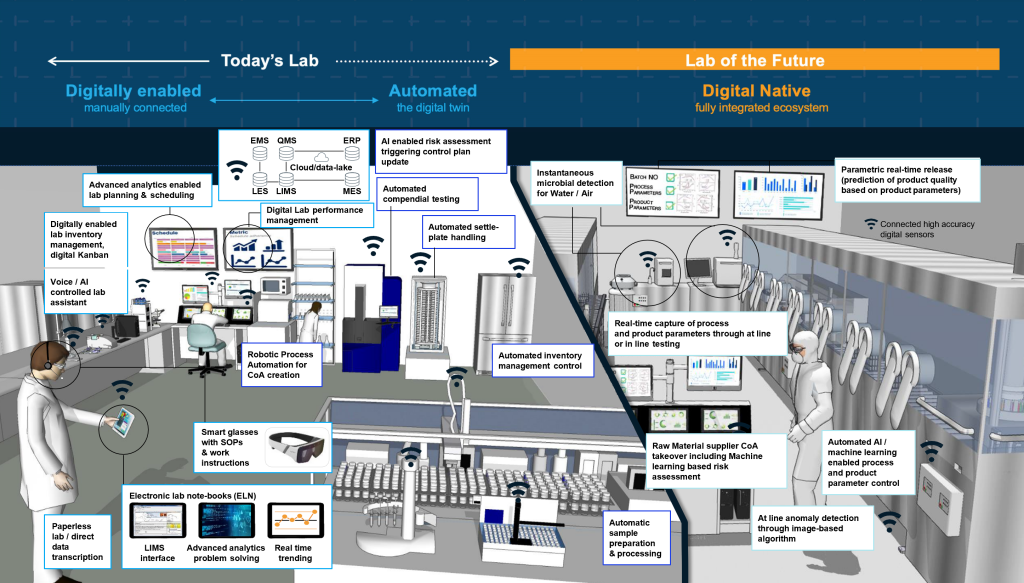 Modern laboratories are changing. New technologies are helping streamline processes, increase throughput, perform work with greater accuracy, and interact more seamlessly with a global community of colleagues, partners, and customers.
Modern laboratories are changing. New technologies are helping streamline processes, increase throughput, perform work with greater accuracy, and interact more seamlessly with a global community of colleagues, partners, and customers.
These exciting new capabilities represent a quantum leap forward for the labs that adopt them, making them significantly more competitive than slower rivals. The winners and losers in this digital transformation will likely be determined in the next few years, making it paramount to begin planning for this future…today.
This is why LabVantage continues to make significant investments toward digital innovations to help your lab enable productivity, manage compliance, and create and capture value in this emerging environment.
But what will the lab of the future actually be like?
Here are a few key predictions we can confidently make, as many of them are based on both emerging technologies and those already available.
Data will drive everything
If a single concept could be said to define the lab of the future, it would be data-centricity. The lab of the future will run on a unified modern platform that seamlessly connects LIMS, ELN, LES, SDMS, and more. The objective is to remove data from silos, structure it, and leverage it to make better decisions.
 Automation and robotics will play defining roles
Automation and robotics will play defining roles
As a shortage of qualified technicians and increasing global competition drive an urgent need for greater productivity, the adoption of “smart quality” has been one of the key drivers for lab digitization and automation.
The ideal role of automation is not to replace human technicians, but to empower them to better perform the tasks they do best. This can be accomplished in a variety of ways, from relieving technicians of arduous processes to assisting compliance with regulations and best practices. Robotics will provide the means for automation to perform physical tasks in the real world.
Promising applications for automation include sample preparation and processing, compendial testing, automatic CoA creation, robotic settle-plate handling, and inventory management control.
Artificial intelligence and machine learning
Neural networks, computer vision, text mining, and other AI/ML technologies are already delivering significant improvements in lab forecasting, classification, optimization, and what-if analysis.
The lab of the future will feature voice/AI-controlled ‘lab assistants,’ while advanced analytics enable more efficient lab planning and scheduling, assist with troubleshooting, manage supply chain challenges, and monitor real-time trends for actionable insights.
Similar tools will be used to enable risk assessment, detect microbes in water and air, predict product quality, refine parameter control, and perform at-line anomaly detection with image-based algorithms.
As AI and analytics technologies mature, partnerships to monetize data will grow, enabling labs to get a 360° view and adopt more distributed decision-making.
 Virtual, mixed and augmented reality
Virtual, mixed and augmented reality
Core technologies of the emerging metaverse are already showing considerable promise in lab applications. For example, LabVantage’s strategic partnership with Holo4Labs, is enabling the integration of Microsoft HoloLens 2 goggles with common LIMS functions.
This mixed-reality solution will soon streamline data entry, empower easier access to materials and information, free up space by eliminating workstations and minimize errors. Check out our recent post about mixed reality to learn more.
Connectivity
COVID-19 accelerated the creation of new virtual and digital connectivity features, making resiliency and lab agility hot topics practically overnight. A powerful shift is already underway toward new modalities which will create new demands and requirements while empowering new opportunities.
Greater connectivity will also be a feature of the lab itself, from direct paperless data transcription to high-accuracy digital sensors.
LIMS will play a central role
LIMS will be at the heart of the fully integrated digital ecosystem of the future by providing the essential link between all the technologies we’ve covered (and others, as well!).
This digital structure will deliver quantifiable business value on multiple levels. Quality will be enhanced by predictive analytics, parametric real-time release, and automation — enabling greater stability as well as shelf-life and process improvements. R&D will benefit from new insights and research opportunities, and early predictions of success or failure. Collectively, these will reduce the number of experiments required, eliminate contamination risks, and help the lab of the future get products to market faster.
The use cases described in this article aren’t just visions of the future, they’re realities that we’re already delivering to forward-thinking laboratories. LabVantage understands the challenges facing the labs of the future, and already uses cutting edge technology and experience to help customers address those challenges.



